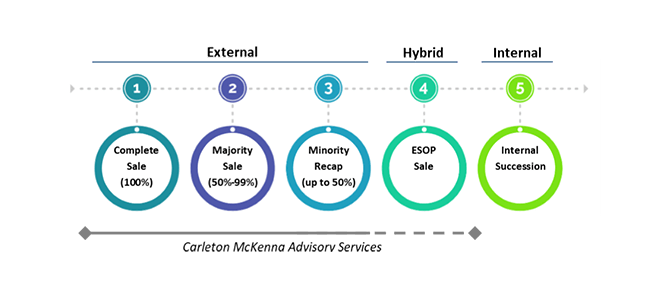Business owners often do not realize the number of different ways there are to transition out of their business. At a high level there are five scenarios for ownership transition. Internal transitions generally see the business passing on to a child, family member or member of the management team without an external auction process. In an external transition, a strategic or financial buyer acquires some or all of the company. An employee stock ownership plan (or ESOP) can be described as somewhere between an internal and external transitions. While CM&Co.’s advisory services are focused on the three external transition scenarios (see diagram below), our team is well-versed in educating and advising on the financial strategies for all types of transitions. Just as no two businesses are alike, no two succession plans are the same. Business owners should think critically about their goals post-transition, including financial needs and desired involvement in day-to-day operations going forward. As you know well, specific actions ahead of time can drive significant incremental value.
A Complete Sale occurs when 100% of company ownership is sold, typically to a strategic buyer or a private equity firm. A Complete Sale results in a full change of ownership control as either a stock deal or an asset purchase. Complete Sales are most frequently asset purchases, as it relieves the buyer from certain liabilities that may be associated with the seller’s prior corporate responsibilities (taxes, product liabilities, etc.) The owner is usually required to stay involved with the company through a transition period (6 months-2 years), particularly if they have played a significant management role. Valuations in a Complete Sale are based on competitive processes and negotiations, and in most industries reflect a multiple of the company’s EBITDA (earnings before interest, taxes, depreciation and amortization). Middle market and lower-middle market companies are generally valued between 5-9x EBITDA depending on a variety of factors including size, profitability, industry, customer concentration, geography, etc. In a Complete Sale transition, the seller usually receives the majority of transaction proceeds upfront with the remaining portion paid later through a seller note or earn-out.
An owner may want to remain more involved and have a “second bite at the apple,” which is often the motivation for a Majority Sale (50% to 99%) of their business to a financial buyer. In this scenario, the owner sells the majority of the business, but retains a small percentage. If the buyer requires an asset purchase, the owner can “rollover” proceeds in a tax efficient way in order to hold this minority position. Buyers must acquire over 50% for the acquisition to be considered a Majority Sale, but 60-85% is the most common range. The “second bite” comes when the new majority shareholder decides to sell, and the original owner cashes out again in the second transaction.
An owner wanting partial liquidity, but without giving up majority control, and looking for a full exit in 5-10 years may be interested in finding a Minority Recap partner. This type of partner acquires less than 50% of a business, allowing the owner to de-risk and “take some chips off the table.” In this type of transition, investors typically acquire 20-40% of the business and often receive a preferred equity position. If the owner is involved in management, often this role continues, but the management team, along with planning and governance processes, are usually enhanced by the investor.
An employee stock ownership plan (“ESOP”) sale allows the business owner to sell all or a portion of their shares to the company’s employees. This strategy can have positive tax advantages for the seller and creates a mechanism for employees to remain engaged in the future of the business. Often, there is no upfront cost to the employees for participating in an ESOP Sale. Instead, the ESOP relies on tax-advantaged seller financing and bank loans to complete the transaction (which can be as high as 50% of the value). The seller usually only receives up to half of the transaction proceeds in cash and the remainder over a 5+ year period. The company valuation is based on discussions between the ESOP trustee and the company and will include discounts to fair market value for the stock, particularly for lack of marketability. Despite the conservative valuation and complex structure, an ESOP Sale may be of interest for owners with distributed execution of a business service. Owners seeking tax advantages, equity/retention incentives for employees and continuity in business operations and management also may want to consider an ESOP.
Internal Succession by a family member (sibling, child, niece/nephew, grandchild or close member of management) is another common theme for privately-held businesses. Internal Succession allows businesses to grow to be second, third or even fourth-generation companies. Keys to successful internal succession by a family member include: proper education and professional development; steady on-boarding of significant roles and responsibilities (or off-boarding for the owner); transitioning key relationships (customers/vendors); and appropriate estate planning with accounting and legal advisors.
The appropriate pre-transition planning can assist first-time sellers (i.e. nearly all business owners) in understanding the various transition options. Choosing which strategy is best for the business owner personally, and for the future of the company, is a vital component when making an exit plan.

